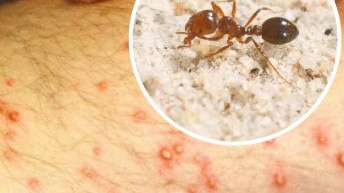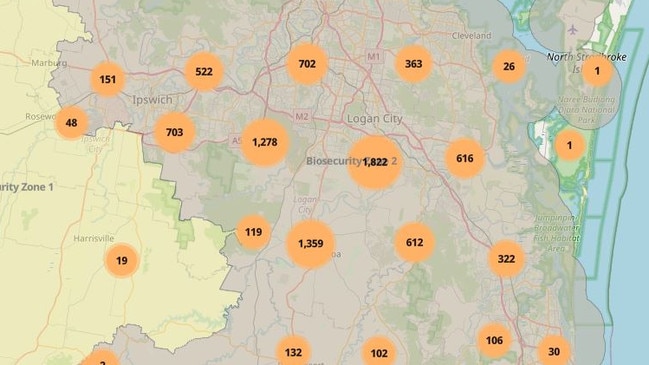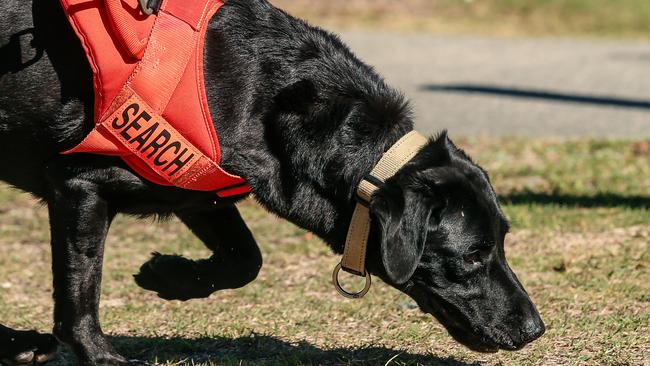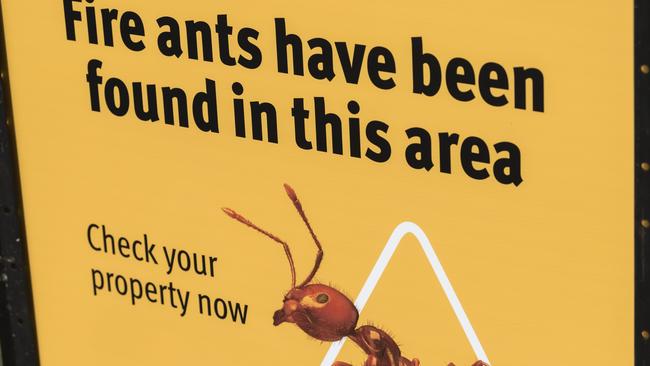Sniffer dogs unleashed against ‘dangerous’ invasive species
Sniffer dogs have been unleashed in the latest attempt to control the spread of a ‘dangerous’ invasive species infesting the east coast of Australia.
Sniffer dogs have been unleashed against a “dangerous” invasive species threatening the east coast of Australia, in the latest attempt to control the infestation.
It comes after five red fire ants nests were discovered in north eastern NSW over the weekend, prompting renewed efforts to squash the imported pest once and for all.
On Tuesday “detection dogs” were deployed around South Murwillumbah to inspect high-risk areas where fire ants nest including soil, mulch, quarry products, potted plants and baled materials.
Fire ants are known to “swarm onto a person or animal stinging it all over, causing the sensation of being on fire,” according to the Department of Primary Industries.

They are a dark-reddish brown colour and can look similar to other ants, apart from the extreme allergic reactions caused by their painful sting.
Fire ants are native to the South American countries of Brazil, Paraguay, Uruguay and Argentina and can kill native plants and animals, “damaging (Australian) ecosystems beyond repair”.
They have infested areas around Brisbane, the Gold Coast, Tweed Heads, North Stradbroke Island, Logan and now Murwillumbah across two “biosecurity zones”.
Minister for Agriculture Tara Moriarty said the latest eradication effort is part of a NSW Government “fire ant plan (focused) on tracing, surveillance and educating local business and community”.
“The on-ground teams from the NSW Department of Primary Industries (DPI) have also been in communication with those businesses within the 5 kilometre biosecurity control zone advising them of their biosecurity obligations under the emergency order,” she said.

“We are working with businesses to facilitate low-risk businesses to get back to normal as soon as possible (and) assisting the high-risk businesses in evaluating their premises and materials so they can also get permits to start moving, with a strong understanding on how to do activities safely and eliminating any risks.”
“I urge everyone in the local area to check their premises, yards and paddocks for the red imported fire ants and then reporting any suspected sighting immediately.”
According to the National Fire Ant Eradication Program, the imported species was first detected at the Port of Brisbane in 2001.
It is understood the pest was likely introduced to Australia via shipping containers from South America where fire ants are know to “hitchhike” aboard cargo.

As of today, the species has infested more than 600,000 hectares of South East Queensland and northern NSW, with thousands of fire ant sites reported in the last 12 months.
The ants are also known to kill pets and livestock, and can damage electrical and agricultural equipment.
Unlike other ants, their nests are distinctive and look like mounds of loose, crumbly, or fluffy soil with a honey comb appearance, up to 40 centimetres high with no obvious entry holes.
Ms Moriarty said co-ordinating efforts between QLD and NSW was essential to curb the spread of fire ants throughout the rest of Australia.
“The NSW Government is working closely with the Tweed Shire Council and the National Program that is led by Queensland, to ensure we’re keeping the community and key stakeholders updated,” she said.

“A community information bus is now outside Tweed Shire Council Chambers (10-14 Tumbulgum Road, Murwillumbah) for locals to obtain more information about what they can do to help stop the spread of these invasive pests.”
Fire ants are killed through direct nest injection of an insecticide called Fipronil- a common termite treatment only used by licensed pest managers.
However, residents can also get their hands on fire ant baits that are encouraged for personal use according to the NFAE Program.
Under the Biosecurity Act 2014, fire ants are considered a “catergory one restricted matter,” and therefore it is the responsibility of all Australians to treat if they are found on your property.
All residents and businesses are encouraged to report any suspicious ant activity to 1800 680 244 or by visiting www.dpi.nsw.gov.au/biosecurity/forms/report-exotic-ants
Originally published as Sniffer dogs unleashed against ‘dangerous’ invasive species




